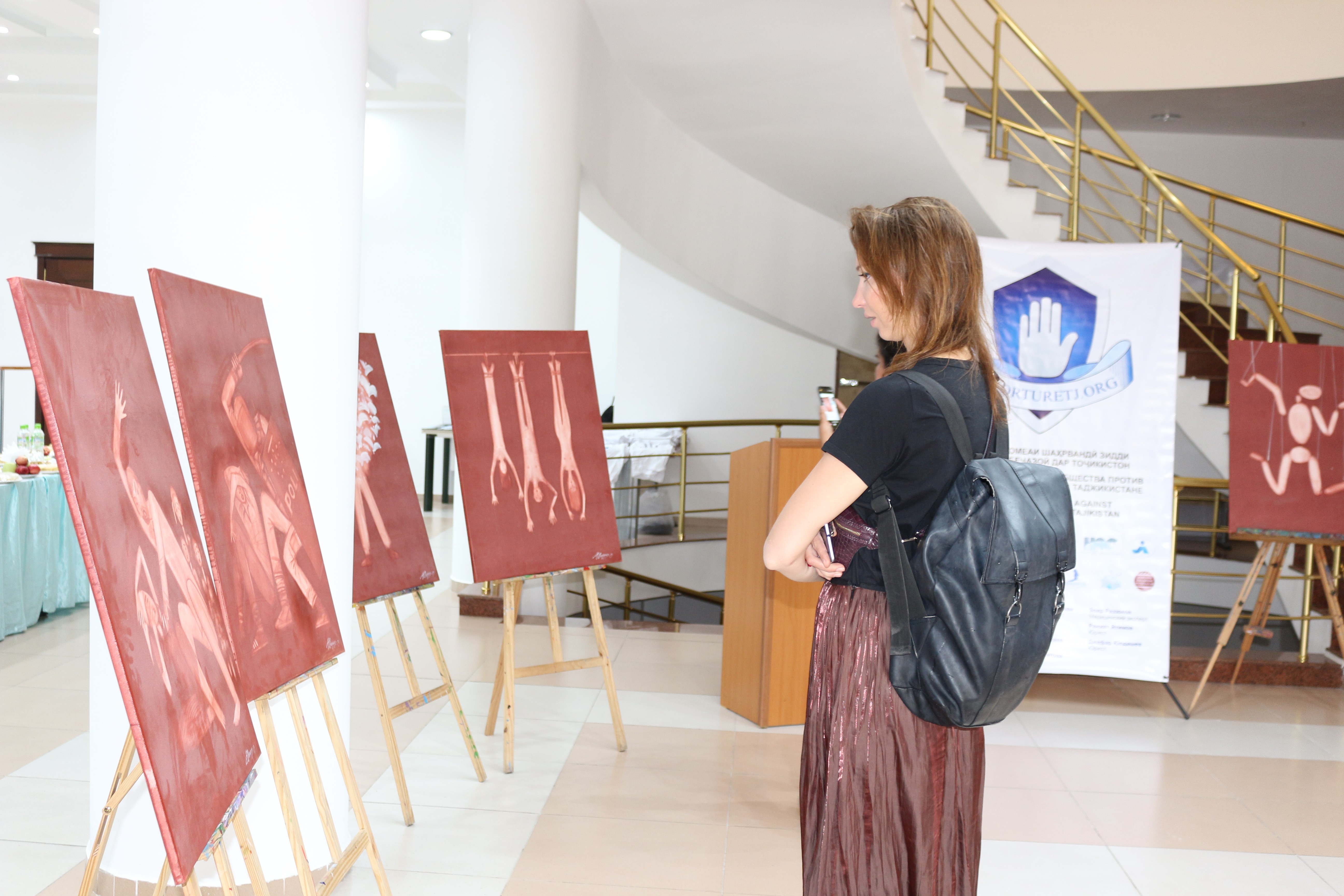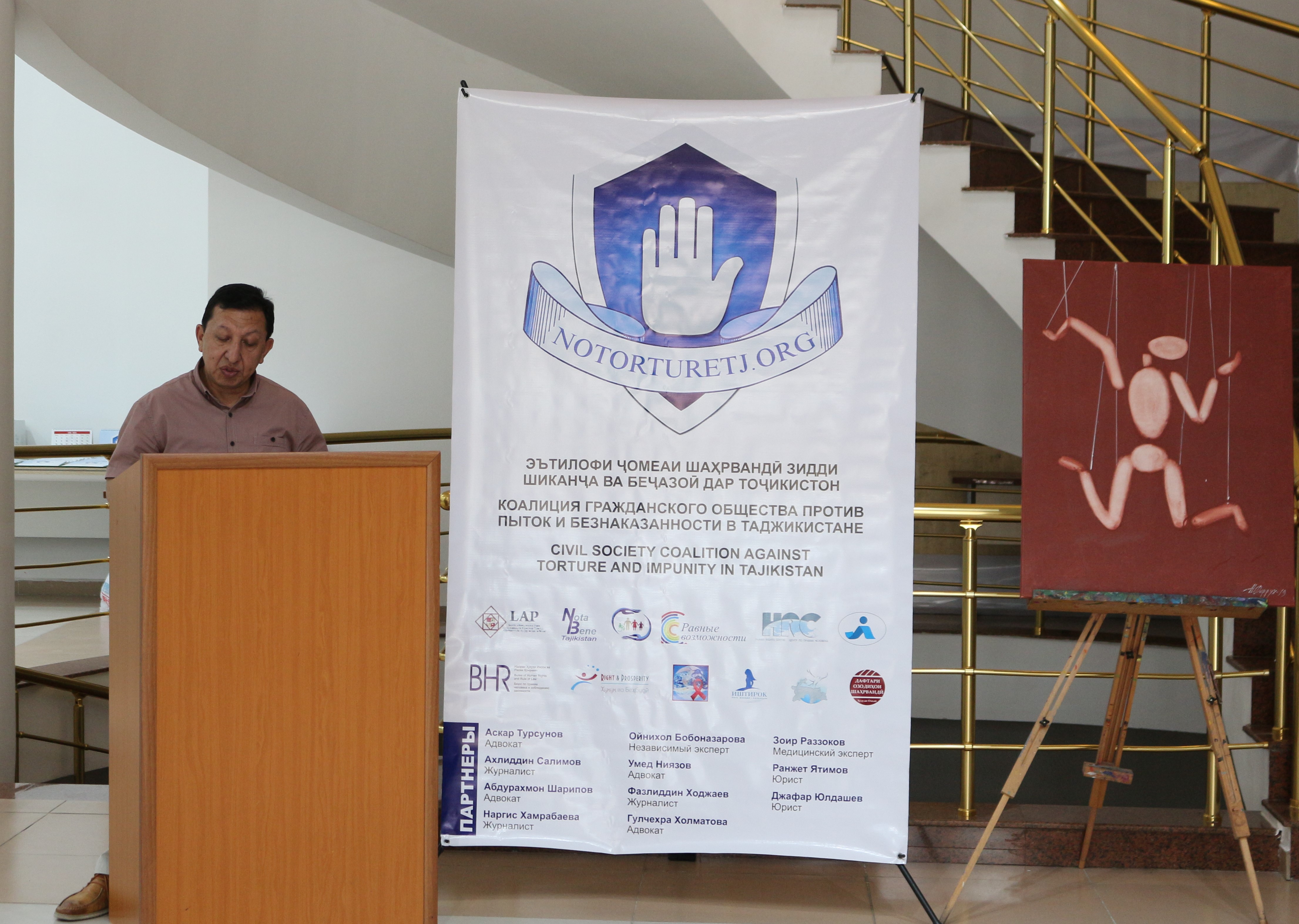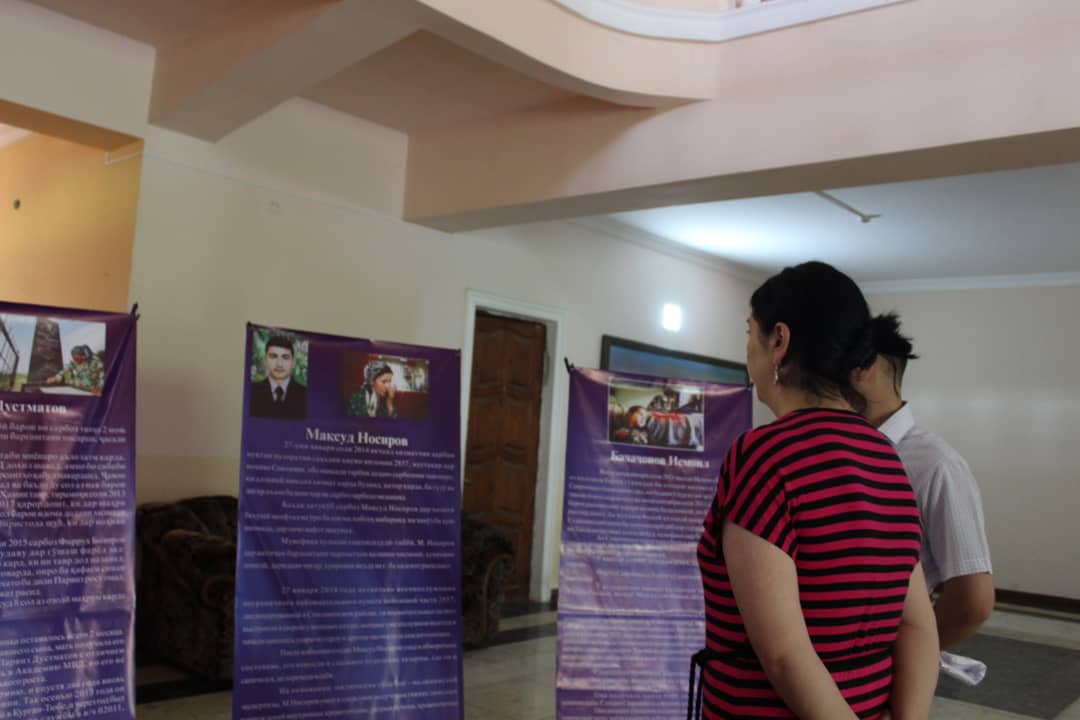Freedom from Torture
Civil Society Coalition against Torture and impunity in Tajikistan

Ten paintings-posters which clearly illustrated what torture is and where it can occur, and most important, how to prevent it, had been presented in the hall of “Vefa Center” complex today.
Demonstration of the works of an artist-activist was accompanied by video sequence and theatrical visualization “Performance” of an actress Firuza Karimova aimed against violence and torture.
Civil society Coalition against torture and impunity in Tajikistan held an event dedicated to the International Day in support of victims of torture which is celebrated on June 26.
The exhibition of the works of an artist-activist Farrukh Negmatzade where the violence topic was explored in a creative form with the elements of performance combining visual art, music and words, under the leadership of art manager Lolisanam Ulugova took place from 10am to midday in “Vefa Center” complex.
In an interview Farrukh Negmatzade noted that often in the everyday routine we are far from the protest against torture and such actions – are significant events to inform people.
 – During the exhibition I was able to communicate with people of different social classes, - says volunteer-activist Safarbek. It`s a difficult subject and the hard part is to accept that this might happen to any of us. Paintings of Farrukh Negmatzade were dedicated to violence in closed institutions, prisons, violence in schools and family, street violence. Indeed, we often shut eyes to the fact that someone shows aggressive behavior on the street, at the bus stop, in the queue. And this has happened almost to any of us. Redirection of aggression in everyday situations finally results in torture and ill-treatment in the police office and hospitals. Ressentiment has an impact on perception of an environment. Among paintings there is one I liked the most, the one symbolizing the released person with white pigeons flying towards blue sky.
– During the exhibition I was able to communicate with people of different social classes, - says volunteer-activist Safarbek. It`s a difficult subject and the hard part is to accept that this might happen to any of us. Paintings of Farrukh Negmatzade were dedicated to violence in closed institutions, prisons, violence in schools and family, street violence. Indeed, we often shut eyes to the fact that someone shows aggressive behavior on the street, at the bus stop, in the queue. And this has happened almost to any of us. Redirection of aggression in everyday situations finally results in torture and ill-treatment in the police office and hospitals. Ressentiment has an impact on perception of an environment. Among paintings there is one I liked the most, the one symbolizing the released person with white pigeons flying towards blue sky.
Head of Civil society Coalition against torture and impunity in Tajikistan Khalilov Nurmahmad emphasized that the concept of the events was to empower people to transform their experience into the performance.
 - It is important that the exhibition visitors to interact with an experience. It is equally important that the society not to be limited to fear, but also could be able to provide support for the victims. Practice shows that torture usually happens without eye-witnesses and a person who experienced it thinks if someone saw it, he/she would help… The main task of our annual events – to express categorical rejection of torture and reaching a large number of people through actions to make them able also to say:
- It is important that the exhibition visitors to interact with an experience. It is equally important that the society not to be limited to fear, but also could be able to provide support for the victims. Practice shows that torture usually happens without eye-witnesses and a person who experienced it thinks if someone saw it, he/she would help… The main task of our annual events – to express categorical rejection of torture and reaching a large number of people through actions to make them able also to say:
“No to torture and impunity!”
This year, a series of events started with traditional photography exhibition dedicated to 27 victims of torture and their family members, which took place in Khujand on June 22 last week.
 However, for the first time the exhibition was held six years ago on June 2013 – the period when Public Organization “The Human Rights and Law Enforcement Bureau” for the first time organized it in Dushanbe on the eve of the International Day of protection of torture victims. During the photography exhibition nine photo-stories had been presented. The six of them were based on high-profile cases of Hamzali Ikromzoda, Khursheda Bobokalonova, Bahromiddin Shodiyev, Safarali Sangov, Ismoil Bachadzhonov and Dilshodbek Murodov who had died at the time of their arrest or in detention.
However, for the first time the exhibition was held six years ago on June 2013 – the period when Public Organization “The Human Rights and Law Enforcement Bureau” for the first time organized it in Dushanbe on the eve of the International Day of protection of torture victims. During the photography exhibition nine photo-stories had been presented. The six of them were based on high-profile cases of Hamzali Ikromzoda, Khursheda Bobokalonova, Bahromiddin Shodiyev, Safarali Sangov, Ismoil Bachadzhonov and Dilshodbek Murodov who had died at the time of their arrest or in detention.
It should be reminded that Civil society Coalition against torture and impunity in Tajikistan was established in 2011 in order to consolidate civil society efforts in the fight against torture and impunity. It is composed of 13 non-governmental organizations, and that is about 80 lawyers, journalists, psychologists, justice experts.
Registration of torture cases, legal and psychological support, bringing the efforts together and requirements for public authorities to shape “zero tolerance” policy for torture in Tajikistan are the main tasks of the Coalition.
All abovementioned events were made possible by financial support of: United Nations Development Program, Sigrid Rausing Trust, OSCE Program Office in Dushanbe and EU representation in RT.